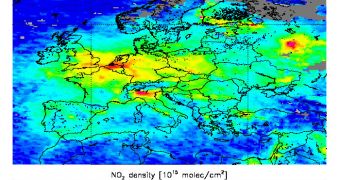European Aeronautic Defense and Space Company (EADS) aerospace subsidiary Astrium has just been awarded a €150 million contract by the European Space Agency (ESA), for the development of the Sentinel-4 satellite mission.
The spacecraft are a part of the Global Monitoring for Environment and Security (GMES) program that ESA is pushing towards aggressively. The two identical spectrometers that Astrium has to build will each fly on Meteosat Third Generation (MTG) weather satellites.
Collectively, the two will be known as Sentinel-4. ESA estimates that the spacecraft will launch to Earth's orbit in 2019 and 2027, respectively. Both will take up geostationary positions some 36,000 kilometers above the Equator.
Sentinel-4's mission will be to provide accurate, reliable, hourly information about the chemical composition of the atmosphere. The datasets will include readings on ultraviolet radiation, ozone, sulfur dioxide, aerosols and rare, trace gases above Europe.
In addition, the satellites are expected to help improve the monitoring of plumes from volcanic eruptions considerably over the coming decades. Using these data, European flight controllers will be able to figure out more easily what to do in the event of a large-scale volcanic eruption.
The contract that made all of this possible was signed on Monday, July 11, at an Astrium facility in Ottobrunn, near Munich in Germany. Astrium Satellites CEO Evert Dudok and the ESA director of Earth Observation Programs, Volker Liebig, signed the agreement.
“This contract marks another significant step forward in realizing ESA's series of Sentinel satellites. Sentinel-4 will be the first spectrometer of this kind placed in geostationary orbit,” Liebig explains.
“This mission will not only provide accurate data for air quality forecasting services, but also provide information about greenhouse gases that can be used by decision-makers in formulating strategies aimed at reducing emissions,” the ESA official adds.
The European Union-mandated GMES program features five families of missions, of which Sentinel is just one. Each of these families will feature several satellites, arranged in strategic constellations. The first Sentinel spacecraft will be launch in 2013.
“Sentinel-4 will be an important MTG instrument for high-definition monitoring of the atmosphere over Europe. As prime industrial contractor, Astrium will coordinate the work of 45 companies in 11 European countries for the construction of the two instruments,” Dudok explains.

 14 DAY TRIAL //
14 DAY TRIAL //